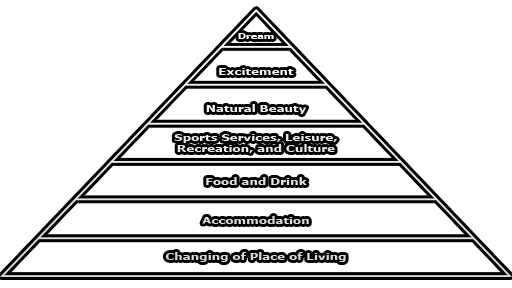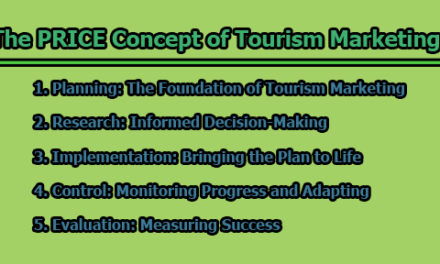Characteristics of New Tourist Needs:
Tourism is a fast-growing industry, and the needs and expectations of tourists are constantly evolving. As people become more experienced travelers, they are increasingly seeking new and exciting experiences when they visit different destinations. In this article, we will explore the characteristics of the new tourist needs, including dream, excitement, natural beauty, sports services, leisure, recreation, culture, food and drink, accommodation, and changing of place of living.
1. Dream: The desire to fulfill a dream or a long-held desire is a significant motivator for many travelers. People may have different dreams, such as visiting a specific destination, experiencing a particular activity, or staying in a unique accommodation. These dreams can be a source of inspiration and motivation, driving people to plan and save for their trips. The tourism industry can cater to these dreams by offering unique and memorable experiences that fulfill the desires of their guests.
2. Excitement: In addition to fulfilling dreams, many tourists are seeking experiences that are thrilling and exciting. These experiences can include adventure activities, such as white-water rafting, rock climbing, or surfing, or cultural experiences, such as attending a traditional dance performance or trying new cuisine. Adventure tourism has become increasingly popular as people seek to push their boundaries and try new things. The tourism industry can offer these experiences by partnering with local tour operators and activity providers to offer a range of exciting activities and experiences.
3. Natural Beauty: The natural beauty of a destination is a significant draw for many travelers. People seek to escape the hustle and bustle of daily life and immerse themselves in the beauty of nature. The tourism industry can cater to this desire by promoting and preserving the natural environment of their destination. Activities such as hiking, kayaking, and wildlife watching can provide opportunities for travelers to connect with nature and appreciate the beauty of their surroundings.
4. Sports Services, Leisure, Recreation, and Culture: Tourists are seeking destinations that offer a range of activities and experiences. These can include sports services such as skiing, golfing, or tennis, as well as leisure activities such as spa treatments or yoga classes. Cultural experiences such as visiting museums, attending concerts or festivals, or exploring historic sites are also popular among tourists. The tourism industry can offer these experiences by partnering with local businesses and attractions to offer a range of activities and experiences for their guests.
5. Food and Drink: Food and drink are an essential aspect of any travel experience. Tourists are seeking destinations that offer a diverse range of cuisine, from local street food to fine dining. Food tours and wine-tasting experiences are becoming increasingly popular as people seek to explore the local culinary scene. Many tourists are also interested in learning about the history and culture of food and drink in different destinations. The tourism industry can cater to these desires by promoting local cuisine and partnering with local restaurants and food businesses to offer unique and authentic dining experiences.
6. Accommodation: The type of accommodation that tourists choose can significantly impact their travel experience. Tourists are seeking a range of accommodation options, from budget-friendly hostels to luxury resorts and private villas. Many tourists are also seeking unique and unconventional accommodations, such as treehouses, yurts, and glamping tents. An accommodation that provides comfort, convenience, and amenities is essential to the overall travel experience. The tourism industry can offer these options by partnering with local accommodation providers to offer a range of options that cater to different needs and budgets.
7. Changing of Place of Living: Finally, many tourists are seeking destinations where they can temporarily change their place of living. These tourists are looking for opportunities to immerse themselves in the local culture and lifestyle, whether that means learning a new language, attending cultural events, or simply enjoying the local cuisine. Longer-term stays in vacation rentals, second homes, or serviced apartments can provide these opportunities. The tourism industry can cater to these desires by promoting longer-term stays and partnering with local businesses to offer opportunities for cultural immersion and language learning.
To add more, now these days, one important aspect of meeting these new tourist needs is the use of technology. The tourism industry is increasingly relying on technology to enhance the travel experience, from online booking systems to virtual reality tours. Many tourists are also seeking destinations that offer sustainable and eco-friendly options, such as electric transportation or renewable energy sources. The tourism industry can use technology to promote sustainable tourism practices and reduce the environmental impact of travel.
Another key aspect of meeting new tourist needs is providing personalized and tailored experiences. Many tourists are seeking unique and authentic experiences that reflect their individual interests and preferences. The tourism industry can use data and analytics to better understand the needs and preferences of their guests and tailor their offerings accordingly. This can include personalized travel itineraries, customized menus, or tailored adventure activities.
Finally, the tourism industry must also prioritize safety and security for their guests. In the wake of the COVID-19 pandemic, many travelers are seeking destinations that prioritize health and safety measures. The tourism industry can implement a range of measures to ensure the safety and security of their guests, such as enhanced cleaning protocols, contactless check-in, and social distancing measures.
In conclusion, the characteristics of new tourist needs are diverse and constantly evolving. The tourism industry must adapt to meet these changing needs and provide travelers with unique and memorable experiences that fulfill their dreams and exceed their expectations. By catering to the desires of travelers for adventure, natural beauty, sports services, leisure, culture, food and drink, accommodation, and changing of place of living, the tourism industry can create a vibrant and sustainable ecosystem that benefits both travelers and local communities.
References:
- Buhalis, D. (2021). The future of tourism: Building resilience and competitiveness. Tourism Recreation Research, 46(1), 3-8.
- Gössling, S., Scott, D., & Hall, C. M. (2021). Tourism and water: Interactions, impacts, and challenges. Current Issues in Tourism, 24(10), 1207-1221.
- Hall, C. M., Scott, D., Gössling, S., & Weaver, D. (Eds.). (2018). Tourism and water. Channel View Publications.
- Kim, S. S., & Ritchie, J. R. (2014). Beyond the conventional tourism development paradigm: Sustainability and well-being. Journal of Travel Research, 53(4), 436-450.
- Li, X., Li, X., Wang, D., & Li, Y. (2021). Examining tourists’ use of technology in-destination experiences. Journal of Destination Marketing & Management, 20, 100495.
- Milman, A., & Pizam, A. (2019). The impact of tourism on quality of life: The case of Florida’s West Coast. Journal of Travel Research, 58(6), 909-921.
- Morrison, A. M. (2013). Marketing and managing tourism destinations. Routledge.
- Page, S. J., & Connell, J. (2019). Tourism: A modern synthesis. Cengage Learning.
- Prideaux, B. (2019). Tourism and water: Interactions, impacts, and challenges. Tourism Recreation Research, 44(3), 413-414.
- (2019). UNWTO Tourism Highlights, 2019 Edition. World Tourism Organization.

Library Lecturer at Nurul Amin Degree College










